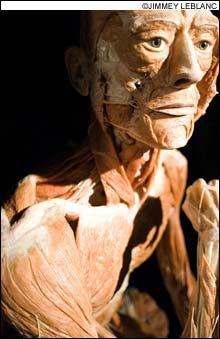
ANATOMIC EMPATHY: “Only when you see it as a partner,” von Hagens says, “are you able to identify with the specimen, to build up body pride.” |
As the story goes, in 1977, German scientist Dr. Gunther von Hagens invented a new way of preserving corpses for anatomical study that entailed replacing the body’s water tissue with fluid plastics. Goodbye jars full of formaldehyde. He dubbed it “plastination” and sold preserved specimens to universities for study. After some years, he realized that average folks found plastinated corpses freaky cool too, so he developed exhibitions of preserved organs and ultimately entire bodies in wacky poses. Ever wondered what a skinned corpse would look like ski jumping? Me neither, but von Hagens kindly provides the answer. These “Body Worlds” shows proved to be hits. Three versions now touring the globe have, at last count, attracted some 20 million visitors. “Body Worlds 2” opened at the Boston Museum of Science on Sunday, and as has been the practice elsewhere, the institution is offering extra evening viewing hours to accommodate anticipated crowds. I anticipate crowds too. Who can resist a good old-time freak show given the respectable imprimatur of science and edumacation? The only thing that could make it more exciting is if the old Watch and Ward Society could ban it.
There is much to learn from here: the red filaments of the arteries of the head and brain, a liver spotted with moldy-looking tumors, a breast invaded by cancer, a steel prosthesis replacing an arthritic knee, nerves dangling like cobwebs on a skeleton, a fatally torn heart ventricle. Von Hagens heightens color contrasts so that parts can be more easily distinguished, but if you’re like me, you may still have some difficulty
telling what is what.
Some specimens aim to scare you off unhealthy behavior. A healthy white lung sits next to a lung turned to charcoal by smoking. It will give you the willies. A fatty slab from a 300-pound man, the label warns, “shockingly reveals the burden the inner organs endured during this person’s shortened life.” His heart gave out in his 50s. The bodies are astonishing in their natural complexity, and the preservation is amazing. I showed photos to a medical researcher I know, and he marveled at the refinement of the “plastinates.”
Most striking are the whole bodies, many posed as if they were in the midst of skateboarding, doing yoga, doing ballet, kicking a soccer ball. The corpse of a pregnant woman, her belly sliced open to reveal her five-month-old fetus, is heartbreaking. The mother is awkwardly posed, but it doesn’t lessen the pang of loss. And her eyes look so stunned and sad. You want to know what went wrong, but the wall text just identifies the intestines, lung, fetus, uterus.
Von Hagens pays careful attention to facial expressions, leaving on eyebrows for greater effect. His skills only occasionally produce more than the odd dull effect, but they do increase your, well, empathy for the corpses. “Only when you see it as a partner,” he told me at the press preview last Friday, “are you able to identify with the specimen, to build up body pride.”